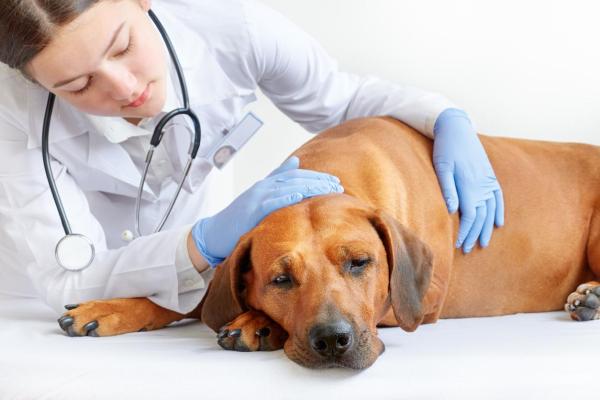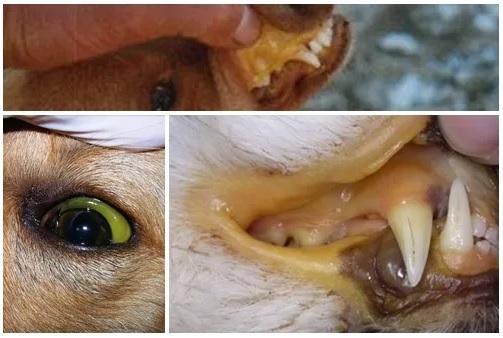Cholestasis in Dogs - Symptoms, Causes and Treatment



See files for Dogs
Cholestasis is a condition that can affect the biliary system of dogs. It occurs when bile is unable to flow from the liver, whether due to a blockage or suppression of bile flow. It results in the accumulation of bile in the liver since it is unable to leave. Determining the specific cause of cholestasis is how the most appropriate treatment will be established in each case. Generally, the causes may be due to a physical obstruction or a condition which affects the formation of the bile itself.
If you want to know more about cholestasis in dogs, AnimalWised explains its symptoms, diagnosis and treatment. If you think your dog may be affected by cholestasis, you will need to speak to a trusted veterinarian.
What is cholestasis in dogs?
Cholestasis is defined as the abnormal accumulation of bile in the liver, bile ducts, or gallbladder. This accumulation of bile is caused by the existence of a blockage or suppression of the bile flow. This either totally or partially prevents the passage of bile to the intestine.
To better understand how cholestasis occurs, we will briefly explain its pathogenesis. Hepatocytes are the parenchymal cells of the liver that carry out most of the functions of this organ. Among other things, hepatocytes are responsible for producing the components of bile and secreting them into the bile canaliculus (the space between two adjacent hepatocytes).
Once in the canaliculus, bile passes into the intrahepatic bile ducts (i.e. those within the liver itself), then into the extrahepatic bile ducts. Finally it travels into the gallbladder where it is stored. When the dog eats a meal with protein and fat, the contraction of the gallbladder occurs and bile flows into the small intestine. This allows proper digestion and absorption of fat. Due to an intra or extrahepatic cause, when the bile does not flow correctly through the bile ducts, cholestasis occurs.
When cholestasis is maintained over time, the hepatocytes end up being damaged. The bile acids present in the bile have a caustic action on the cell wall of the hepatocytes.
Types of cholestasis in dogs
Depending on the cause of the abnormal accumulation of bile in the liver, cholestasis is classified into two types:
- Intrahepatic cholestasis: when the cause of cholestasis is found in the liver itself and affects the intrahepatic bile ducts.
- Extrahepatic cholestasis: when the cause that produces cholestasis is outside the liver, affecting the extrahepatic bile ducts.
In the following section, we explain the different causes leads to intrahepatic and extrahepatic cholestasis in dogs.
Causes of cholestasis in dogs
As we have explained, the causes of cholestasis vary depending on whether it is intrahepatic or extrahepatic cholestasis.
Intrahepatic cholestasis
The main causes of intrahepatic cholestasis in a dog are:
- Obstruction of the intrahepatic bile ducts: caused by parasites, thick bile syndrome, inflammation of the bile ducts (cholangitis) or tumors of the bile ducts (cholangiocarcinoma).
- Inflammation or fibrosis at the level of the portal space: the portal spaces are tubular structures that cross the liver. Through them pass blood vessels, lymphatic vessels and bile ducts. When these spaces become inflamed or fibrotic, they compress the structures inside them, including the lymphatic vessels.
Extrahepatic cholestasis
Extrahepatic cholestasis occurs when there is an obstruction in the extrahepatic bile ducts or the gallbladder. In turn, this obstruction can be caused by:
- Gallstones, parasites or clots: they obstruct the lumen of the extrahepatic bile ducts.
- Thick bile syndrome: when the bile is so thick it doesn't flow properly and blocks the bile ducts.
- Tumors (cholangiocarcinoma) or inflammatory processes (cholangitis): affect the wall of the bile ducts.
- External compression of the bile ducts: due to pancreatitis or lymphadenitis of the portal or mesenteric nodes. When these organs increase in size, they can compress the bile ducts from the outside and obstruct them.
Symptoms of cholestasis in dogs
The main sign of cholestasis is jaundice. This causes a yellowish coloration that is observed in the skin and mucous membranes. It is a consequence of the deposit of bilirubin. Usually, bilirubin is excreted through the bile. However, in the case of cholestasis, this pigment accumulates in the liver and passes into the blood, producing hyperbilirubinemia (increased levels of bilirubin in the blood).
When bilirubin levels in the blood are higher than 2 mg/dl, it is deposited in the tissues, giving rise to jaundice. In dogs, jaundice is more easily observed in the sclera (whites of the eyes), although it can also be seen in the oral mucosa, genital mucosa and even in the skin when bilirubin levels are very high. Jaundice can also be the reuslt of other pathologies such as hepatitis in dogs.
In addition to jaundice, when a total obstruction of the bile ducts occurs, the following clinical signs can be observed:
- Maldigestion/malabsorption syndrome: the bile salts present in the bile are essential for the digestion and absorption of fats. When the bile is not able to reach the intestine, a maldigestion/malabsorption syndrome appears, characterized by the appearance of osmotic-type diarrhea. Learn more with our article on diarrhea in dogs caused by malabsorption syndrome.
- Steatorrhea: the presence of fat in the stool. When the bile salts do not reach the intestine, the fats are not digested or absorbed, so they are eliminated with the feces.
- Colorless stools (acholic): the color of the dog's stool is due to the presence of stercobilinogen, a metabolite obtained from bilirubin. In cases of cholestasis, the bilirubin contained in the bile does not reach the intestine, which means that stercobilinogen is not produced and the stool is colorless.
- Bleeding: during cholestasis, vitamin K malabsorption occurs. The deficiency of this vitamin can lead to alterations in secondary haemostasis (the body's process to stop bleeding), potentially making it easier to bleed or bleed more profusely.
- Bacterial cholangitis: when the obstruction is complete, bacteria from the intestine can ascend the bile duct and colonize the bile ducts, producing bacterial cholangitis.
When there is an extrahepatic obstruction that persists over time, the bile ducts or the gallbladder itself can rupture. When the bile falls into the abdominal cavity, it generates peritonitis that can be septic or aseptic, depending on whether or not bacterial contamination occurs.

Diagnosis of cholestasis in dogs
Now that the main causes and symptoms associated with cholestasis have been described, we will explain its diagnosis. The diagnostic protocol for cholestasis in dogs should be based on the following points:
- Clinical history and physical examination: as we have detailed in the previous section, dogs with cholestasis usually present jaundice, although digestive signs (diarrhea, steatorrhea and discolored stools) as well as abdominal pain can also be observed.
- Blood tests with liver profile: the most characteristic feature of cholestasis is the increase in two liver enzymes, alkaline phosphatase and GGT (gamma-glutamyl transpeptidase). The increase in these enzymes occurs prior to the onset of jaundice. In addition, an increase in the levels of bilirubin in the blood can be observed. Learn more with our article on how to understand a dog's blood test.
- Abdominal ultrasound: When there is an obstruction of the bile ducts, the bile cannot reach the intestine, so it accumulates in the bile ducts. As a consequence, there is a dilation of the bile ducts and/or the gallbladder that can be visualized by ultrasound. However, the gallbladder may simply be dilated due to anorexia (if the animal does not eat, the stimulus for its emptying is not produced). Therefore, to diagnose an obstruction of the bile ducts, it is necessary to visualize not only the dilatation, but also the obstructive cause. In cases of gallbladder rupture, the ill-defined gallbladder area and the presence of free fluid in the abdomen can be observed.
- MRI: this advanced imaging test can help detect the presence of an obstruction in the extrahepatic biliary tract.
- Exploratory laparotomy: when ultrasound detects dilation of the bile ducts, but the cause of the obstruction is not observed, exploratory surgery of the abdominal cavity may be necessary to make the causal diagnosis.
Treatment of cholestasis in dogs
The treatment of cholestasis in dogs should be directed at the cause that produces it , and may include medical treatment, surgical treatment or both.
Medical treatment
Medical treatment will vary depending on the cause of cholestasis, and hepatoprotectors (such as ursodeoxycholic acid or silymarin), antibiotics, vitamin supplements (including vitamin K, E or D), fluid therapy when dehydration presents, etc. may be administered. In addition, it is important to restrict the fat content of the diet until normal bile flow to the intestine is restored. In this way, the foods prohibited in dogs with cholestasis are those rich in fat.
You can find suggestions for a diet for dogs with cholestasis with our homemade recipes for overweight dogs.
surgical treatment
Surgical treatment is usually necessary when cholestasis is caused by extrahepatic obstruction. Surgical options may include:
- Removal of the gallbladder (cholecystectomy): since a dog without a gallbladder can continue to have a good quality of life.
- Opening of the gallbladder or bile ducts: to remove stones, clots, or other things that block the bile ducts.
- Placement of stents in the bile ducts: to keep them open to the passage of bile.
- Removal of tumors: since they externally compress the bile ducts, removal should allow flow of bile to return.
As we can see, there is no natural treatment for cholestasis in dogs, beyond changing their diet. It is necessary to go to the veterinary clinic to obtain a proper diagnosis and treatment.
This article is purely informative. AnimalWised does not have the authority to prescribe any veterinary treatment or create a diagnosis. We invite you to take your pet to the veterinarian if they are suffering from any condition or pain.
If you want to read similar articles to Cholestasis in Dogs - Symptoms, Causes and Treatment, we recommend you visit our Other health problems category.
- Del Valle, S., Piñera, M., Medina, N., & Sanchese, J. (2017). Cholestasis: An Updated Approach. Medisan, 21(7):876.
- Suarez, M., Gonzales, E., Seonane, A., & Santamrina, G. (2017). Clinical case of internal medicine. Official AVEPA Magazine of AVEPA, 37(3).






